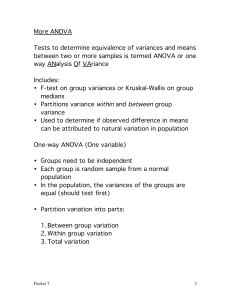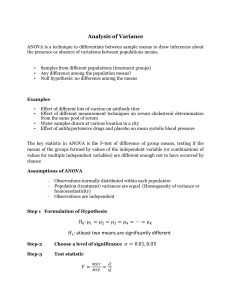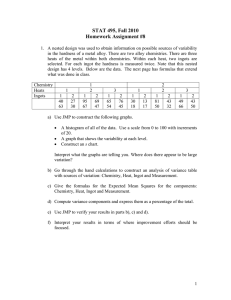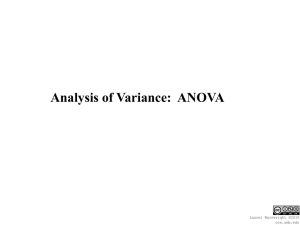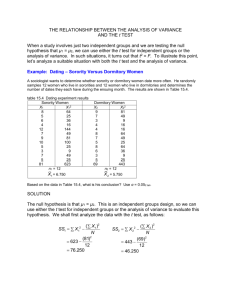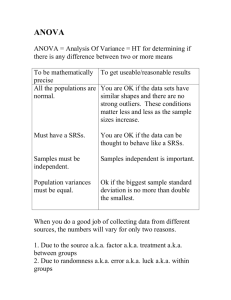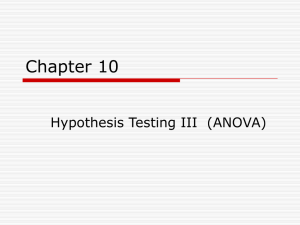ANALYSIS OF VARIANCE
advertisement
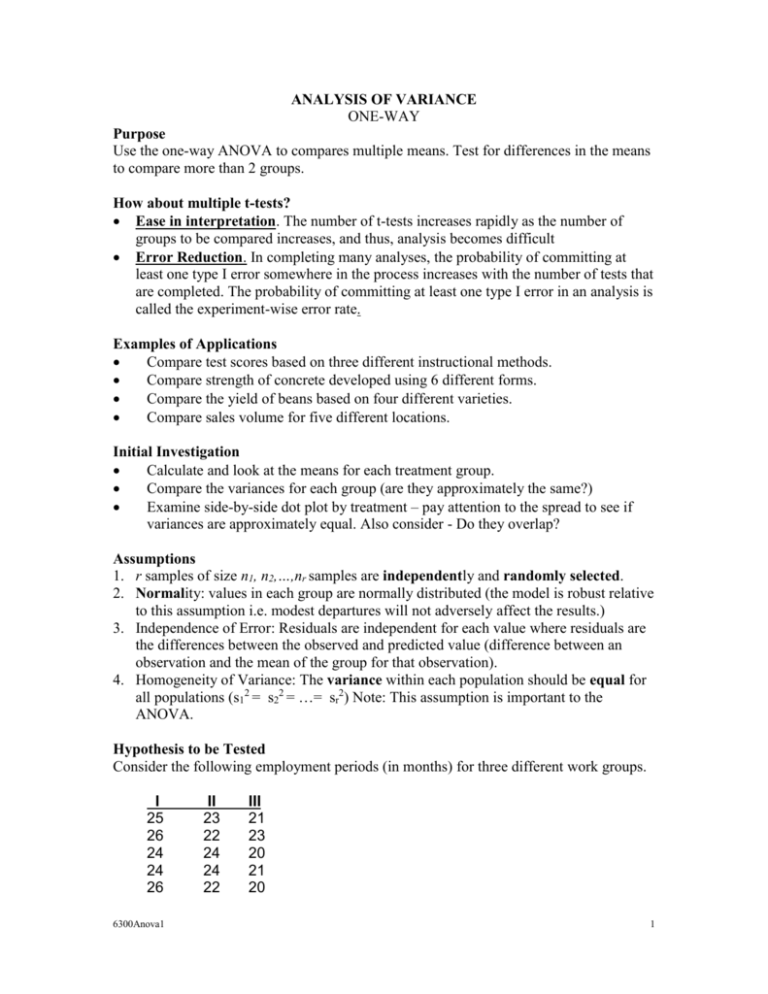
ANALYSIS OF VARIANCE ONE-WAY Purpose Use the one-way ANOVA to compares multiple means. Test for differences in the means to compare more than 2 groups. How about multiple t-tests? Ease in interpretation. The number of t-tests increases rapidly as the number of groups to be compared increases, and thus, analysis becomes difficult Error Reduction. In completing many analyses, the probability of committing at least one type I error somewhere in the process increases with the number of tests that are completed. The probability of committing at least one type I error in an analysis is called the experiment-wise error rate. Examples of Applications Compare test scores based on three different instructional methods. Compare strength of concrete developed using 6 different forms. Compare the yield of beans based on four different varieties. Compare sales volume for five different locations. Initial Investigation Calculate and look at the means for each treatment group. Compare the variances for each group (are they approximately the same?) Examine side-by-side dot plot by treatment – pay attention to the spread to see if variances are approximately equal. Also consider - Do they overlap? Assumptions 1. r samples of size n1, n2,…,nr samples are independently and randomly selected. 2. Normality: values in each group are normally distributed (the model is robust relative to this assumption i.e. modest departures will not adversely affect the results.) 3. Independence of Error: Residuals are independent for each value where residuals are the differences between the observed and predicted value (difference between an observation and the mean of the group for that observation). 4. Homogeneity of Variance: The variance within each population should be equal for all populations (s12 = s22 = …= sr2) Note: This assumption is important to the ANOVA. Hypothesis to be Tested Consider the following employment periods (in months) for three different work groups. I 25 26 24 24 26 6300Anova1 II 23 22 24 24 22 III 21 23 20 21 20 1 The Hypotheses to be tested are Ho: 1 = 2 = … r (all group means are equal) Ha: not all mean are equal (At least one group mean is not equal to another.) Source of Variation (Why do the means vary?) Between Group Variation (treatment) - The treatments may produce different results. A large effect of the treatment will result in more variation in the group means. Within Group Variation (error) - People and specimens are simply different; they differ whether we treat them the same or not- random variation. Note: Even if Ho is true (i.e. all group means are equal), there will be differences in the means; random variability in the samples will create the differences. If Ho is true, the between group variation will estimate the variability, as well as the within group variation. If Ho is false the between group variation (the variation that occurs because the treatments are different) will be larger than the within group variation (the random variation). The F-Test The variation between or within groups is the basis for the F-test. Consider the following sum of squares. Total Variation (SST) - includes both between group and within group variation (variation without regard to treatment) SST = SSB = SSW = SST = Total sum of squares (uses the difference between cell mean and grand mean) Sum of Squares Between groups (uses the differences in sample means variation due to different treatments. Note, some use the notation SSA or SSTr.) Sum of Squares Within groups (uses the differences in each observation and mean of its own group random variation. Note, some use the notation SSE) SSB + SSW = SSTr + SSE Variance Variance is referred to as “mean square” and is calculated as follows. Mean Square Treatment: MSB = SSB/(r-1) = SSTr/(r-1) Mean Square Error: MSW = SSW/(n-r) = SSE/(n-r) 6300Anova1 2 F = MSB/MSW (or sometimes noted as MSTr/MSE) Where: df numerator = r - 1 where df denominator = n - r r= n= # of groups (The text uses c instead of r) total # of observations Reporting Results Results of an ANOVA should be reported in a summary table that includes the following values. ANOVA Summary Table Source Between Within Total df r-1 n-r n-1 SS SSB SSW SST MS SSB/(r - 1) SSW/ (n - r) F MSB/MSW Simultaneous Confidence Levels: Comparing Multiple Means Pooled Sample Variance is used to construct the basic confidence interval estimate: sp2 may be thought of as an “average” variance for each groups or the weighted average of the sample variances where sp2 = MSE. It estimates the baseline variation that is present in a response variable. (Note that the ANOVA assumes equal variances and equal variances are required to find the pooled standard deviation.) For the Pooled Sample Variance: r = number of samples ni = sample sizes si2 = sample variances In general, construct the confidence intervals using: Bonferroni Inequality Tukey’s Comparison 6300Anova1 3
